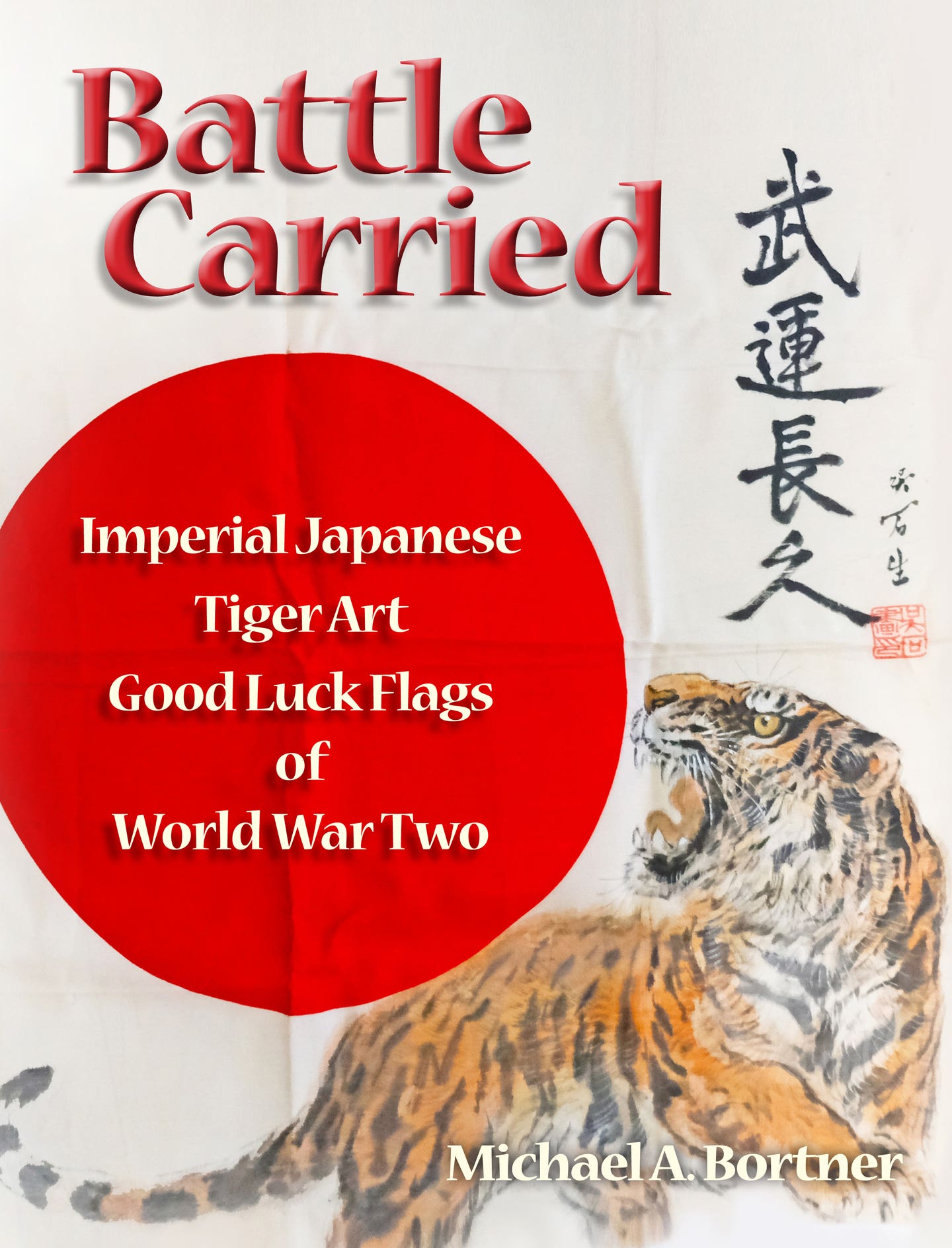Book Review: Battle Carried. Imperial Japanese Tiger Art Good Luck Flags of World War Two
For the first time in English, this book explores the deep meaning of tiger imagery used to inspire thousands of Japanese soldiers, sailors, and airmen in WW2
Battle Carried: Imperial Japanese Tiger Art Good Luck Flags of World War Two, by Michael A. Bortner (ISBN: 978-1-943492-57-2. Elm Grove Publishing. Available from the author: Michael Bortner, Fortunes of War Militaria, P O Box 927, Belvedere-Tiburon, CA 94920; fortunesofwarmilitaria@gmail.com; www.fortunesofwarmilitaria.com. Hardcover, 196 pages, more than 210 color and b/w illustrations, 2021, $69.99).
“With a flag you lead men, for a flag, men live and die. In fact, it is the only thing for which they are ready to die in masses, if you train them for it.”
When Theodr Herzl wrote the above to Baron Maurice von Hirsch, he was describing the devotion that people could be inspired to with a simple flag. In the 20th century, that devotion was embodied in pre-war Japan with the “good luck” flags the nation sent with their soldiers going off to war.
For more than 50 years, author and collector, Dr. Michael A. Bortner, has collected imperial Japanese good luck flags and one-thousand stitch belts. In fact, his book on the subject, Imperial Japanese Good Luck Flags and One-Thousand Stitch Belts (Schiffer: 2008), revealed to collectors, dealers, and museums, the nuances that make these textiles so desirable and important testaments to history.
This new volume, Battle Carried, focuses solely on the iconographic tiger art, sometimes found painted on “good luck flags” (hinomaru yosegaki). Drawing upon an extensive collection of tiger-painted good luck flags and amulets, gathered from fellow collectors worldwide, the author has assembled the first work of its kind on the subject in English.


The book begins with a thorough examination of tiger imagery popular in Asian art, surveying the symbolic meaning of the divine creature. This provides the backdrop for an in-depth examination of the use of tiger imagery in a variety of depictions specifically on good luck flags and amulets.
In addition to tigers decorating these flags, slogans and inscriptions usually adorn them, as well. Thankfully, the author has translated much of the kanji characters depicted on the flags to illustrate the book. This makes it easy for a student to match characters and begin the process of deciphering the inscriptions on a particular flag.
Printed on non-gloss pages, the reproductions are crisp and bright, allowing for magnified study of particular photos. The captions make up the bulk of the text in the chapters about various tiger stance depictions. These are straight-forward and make it easy to interpret the illustrated details.
Finally, an extensive glossary translates hundreds of Japanese expressions on the flags. Though not presented with the kanji characters, it will serve as a useful reference when translating flag inscriptions.
Battle Carried is a volume written for the serious militaria collector or student of Imperial Japan. It expands, in depth, an aspect only touched upon in the author’s previous work, Japanese Good Luck Flags.
Studying the elaborate artwork and reading both the loving and inspiring inscriptions to soldiers, sailors, and airmen on these rarest of “good luck” flags, it becomes obvious what Herzl meant when he wrote to his friend that a flag “is the only thing for which they are ready to die...”
In addition to collectors of Imperial Japanese militaria, aficionados, historians, artists, and scholars of Japanese culture will embrace Battle Carried. It has become the principal study of Japan’s tiger imagery used to inspire legions of military personnel during the first half of the 20th century. — John Adams-Graf, editor, Military Trader
You may also enjoy
*As an Amazon Associate, Military Trader / Military Vehicles earns from qualifying purchases.
John Adams-Graf ("JAG" to most) is the editor of Military Trader and Military Vehicles Magazine. He has been a military collector for his entire life. The son of a WWII veteran, his writings carry many lessons from the Greatest Generation. JAG has authored several books, including multiple editions of Warman's WWII Collectibles, Civil War Collectibles, and the Standard Catalog of Civil War Firearms. He is a passionate shooter, wood-splitter, kayaker, and WWI AEF Tank Corps collector.








